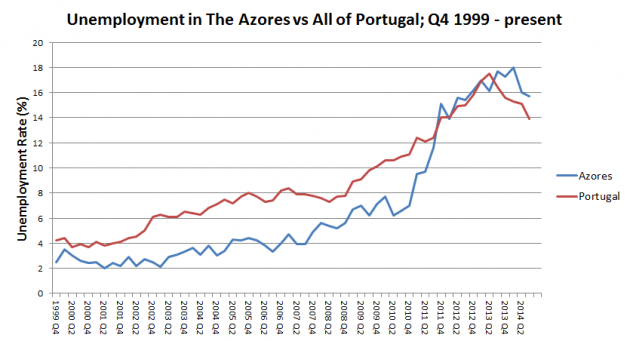The rocky outcrop of The Azores has been talked about more than is usual in Northern Ireland in recent months and years. This isn’t due to its sudden explosion in popularity as a holiday destination for the good burghers of Ulster, but because of a 2006 ruling of the Court of Justice of the European Communities. This decision concerned Portugal allowing its autonomous regions to reduce the rate of personal and corporate taxes by 30%, which the territory of The Azores duly exploited to the full by cutting its tax rates by this amount in the year 2000. When the tax cut was implemented, the rate in The Azores was 26.18% compared to 37.4% in the rest of Portugal. Today, the rate in mainland Portugal is 23%, and the rate in the Azores is 16.1%.
The Court held that Portugal’s decision was, in fact, a form of state aid, and was only legal if the cost of the lost taxation revenue was borne by the territory itself. This decision affects Northern Ireland in a fundamental way. For some time, it has been the stated aim of the Northern Ireland Executive to equalize the Corporation Tax rate across the Irish border; the rate in the Republic is 12.5%, whilst the rate in Northern Ireland (for large companies) is 21%. It has been stated that equalizing the rate on both sides of the border will attract jobs and investment to Northern Ireland, allowing for equal competition for foreign direct investment and stimulating entrepreneurial activity.
However, the Azores ruling means that the Northern Ireland Executive will have to pay for this tax cut by a reduction in the block grant, the money distributed from Westminster to the Northern Ireland Government, and therefore must be paid for in terms of a reduction in Northern Ireland Government spending. In fact, the total reduction in spending provided for in the draft budget (£213m, although this figure masks increases in Health, DETI, and Education spending, so the actual cuts are far higher) is eerily similar to the foregone revenues from the proposed Corporation Tax cut, which I have estimated at £222m, within a few percent of this sum. So what would have been a large enough cut in local government spending has become a very severe cut to pay for the Corporation Tax cut.
So are The Azores luxuriating in their new high growth, high-tech economy after reducing their own Corporation Tax cut rate? Well, it is true that when they reduced their tax rate in 2000, their unemployment rate did indeed decrease. For a while.
The Azores had a sprightly decade from the implementation of the Corporation Tax cut, economically speaking. They were helped by a benign wider economic climate, substantial assistance from European Union funds, and (this may start to sound familiar) a substantial and growing public sector, and a booming construction sector. The lower rate of Corporation Tax may have played a part too.
However, the party didn’t last. Despite managing to keep a gap between unemployment rates in The Azores and those in the rest of Portugal until 2011, the rates have since converged, and now unemployment in The Azores is higher than Portugal as a whole, at just under 16%.
The Azores have been under pressure to get their deficit and large public sector headcount under control, but the Socialist administration of the archipelago have proved resistant, and in further echoes of the situation in Northern Ireland, have had to borrow €135m, linked to public sector reform and fiscal restraint.
There will be no such forbearance in Northern Ireland, however. Unlike the situation in The Azores, where the Corporation Tax cut was essentially on tick, and in a friendly economic climate, the cuts in Northern Ireland will cause widespread job losses, and are in the midst of a sustained difficult economic environment.
Of course, there are many differences between The Azores and Northern Ireland. The Azores don’t have a land border with an EU state with a lower tax rate, and are much smaller both in area and population (246k in The Azores, 1.8m in NI). But the parallels are interesting. Despite having very benign circumstances, the Corporation Tax cut in The Azores did not lead to a sustainable, private-sector led economy, and they are now faced with an unemployment predicament that will prove difficult to resolve.
The European Union have released a very interesting document on the situation in The Azores. Particularly interesting is the section on unemployment, “A high level of unemployment, a new reality in The Azores”. Various policies for mitigating the unemployment dilemma are discussed, key amongst them youth apprenticeships, and schemes to encourage women into the workplace through family-friendly policies, especially those from disadvantaged backgrounds. These are precisely the schemes that are being decimated by the cuts at the Department of Employment and Learning, as well as the cuts to university funding that are likely to seriously hamper the long term skills base.
The entire concept of encouraging growth by lowering corporate tax rates has come in for serious criticism from academics in recent weeks, with a paper by Alexander Ljungqvist and Michael Smolyansky, economists at New York University, arguing that corporate taxes at a regional level are asymmetric, meaning that raising them does harm but cutting them doesn’t actually do any good.
Northern Ireland stands at a crossroads. It proposes to grant local corporations a large tax cut, the benefits of which are debatable at best, and which will be paid for by cuts to the services that other countries have shown can mitigate unemployment. It may be tempting for the European Union, drafting a document in the year 2026 entitled “A high level of unemployment, a new reality in Northern Ireland” to state, simply, “we told you so.”
A qualified accountant and data analyst, interested in politics, economics and data. Twitter: @peterdonaghy
Discover more from Slugger O'Toole
Subscribe to get the latest posts to your email.
